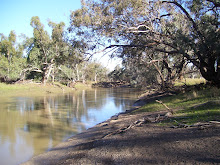A word of warning here! This is not a "how to do it" guide! It is merely an account of how I did the install!
If you like your free camping and a few luxuries then you need elecktrickery of some sort! The Sterling runs a 12 volt DC lighting and 12 volt water pump setup. When on a powered site the 240V AC goes thru the Setec ST35 power supply which acts as a trannie (no, not THAT sort of trannie, Alice) and a battery charger for the 110Amp Hour AGM battery.
The choices when free camping are a generator - not in a National Park however, run the tow vehicle for an hour or so a day to charge the battery, or fit a solar panel. After a quick discussion with Spanner it was decided that a solar panel was the go.
I love the internet! Bang in "solar panel caravan" and there is all the information you could wish for. Some of it is conflicting but look further, chase links and use some common sense then make a decision!

Here is the roof of the Sterling with the question being, where do I put the panel?
The van has an ensuite at the rear so the extra 15kg of panel across the roof here would, in my humble opinion, lighten an already light ball weigh. The battery is also up the front under the bed so that would mean a long run of volt eating copper cable or expensive non volt eating cable!
Another option was along the near (left) hand side of the van. I was not happy with the roof supports I would be fastening to here and running cable presented a problem as well.
And the decision is:
Across the front of the van, directly in front of the front roof hatch. Lotta fronts Eh!! Sound like Tim Bailey. This location provided adequate fastening points and best of all a straight cable drop thru a wardrobe ( that's a closet to you Tex!) and under the bed to the battery.
I had chosen a Sharp 130 watt panel, part number ND-130T1J, purchased on the internet from Todae. See link below:
http://www.todae.com.au/Products/allsolarpanels/130wsharpsolarpanel/A suitable solar regulator to protect the battery from overcharging and stop current feedback to the panel at night was also purchased. Installation and user instructions for the Setec say that with a solar panel install the solar regulator is cabled directly to the battery and not through the Setec so that is how it was done.

Sharp panel in untidy workshop!
I used 6mm auto cable because the run is only 2.6 metres. There is a formula to work out current drop via cable size and from my 1960's maths education, 6mm would/should be adequate. 6mm cable runs from the Setec to the battery as an original install. I soldered every join that I could. The battery lugs were clamped. I included an in-line auto type fuseholder with a 10 amp fuse between the solar regulator and the battery. This amperage fuse was chosen because the specs sheet for the panel said the Maximum Power Current output is 8.09 amps.
I didn't want any of this elecktrickery stuff running backwards from the battery and frying the solar regulator, or worse still, the panel. There already is a 35 amp fuse on the cable from battery to the Setec.

110AH AGM showing both fuse holders.
Solar panels perform best at 25 degrees C. For every 10 degrees C above this they loose approximately 5% of their output. So flat mounting the panel to the roof with no air gap underneath would reduce efficiency on hot days. Because of the location of supports in the roof of the van I built up my own mounting system for the panel, lifting it 12mm above the roof to allow some air circulation but not too much wind resistance when travelling. See pic below.

The next challenge was to get 15kg of panel and mounting system onto the roof safely. Spanner couldn't help as she fell down a flight of stairs whilst working and broke her arm! Oak Flats Harry came to the rescue and passed the panel up to me on the roof. A few weeks ago I had polished the fibreglass roof and it was slippery!
I had cleaned the area where the mount would sit with a good quality wax and grease remover as the panel would be fixed with a sealer/adhesive made by Fuller called Toolbox as well as mechanically fastened with stainless screws.
Once again the Internet came into use here in finding a suitable sealer/adhesive. The data sheet for Fullers Toolbox stated that it resisted salt and chlorinated water, was suitable for sealing shower units, had a 3.2 MPA hold/tear strength, was heat resistant to 100 degrees C, was compatable with alloy and fibreglass. And you can buy it at Bunnings!

Toolbox adhesive/sealer in white and stainless fixing screw.
The panel was then fixed to the roof with Toolbox and the stainless screws. A studfinder was used to locate the roof supports to fix to. I used a hole saw to cut through the roof into the cupboard space underneath and passed the cables thru and sealed it all up with Toolbox also.
All cabling is now connected and the panel is hopefully doing the job. My neighbour down the road is an electrician and I am trying to catch him at home on a sunny day so he can take some measurements for me.
Below is a pic of the finished job. The Toolbox sealing the stainless screws looks a little untidy but functionality must win out over looks everytime! And you can't see it from the ground anyway.



